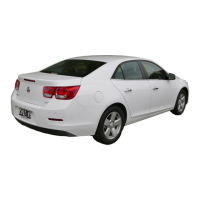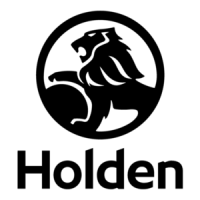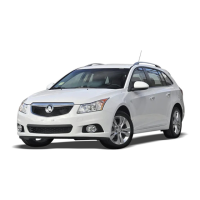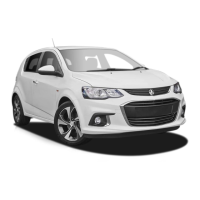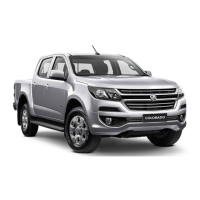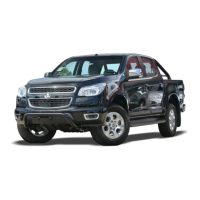Do you have a question about the HOLDEN EM MALIBU 2013 and is the answer not in the manual?
Overview of the vehicle's instrument panel and its components.
Provides a brief overview of important features for initial driving.
Details on various vehicle features like radio, steering wheel controls, and cruise control.
Information on traction control, electronic stability control, and tyre sealant kit.
Covers keys, remote keyless entry system, and door lock operations.
Details regarding the boot and its release mechanisms.
Information on the anti-theft alarm system and immobiliser operation.
Adjusting and features of convex, power, folding, and heated exterior mirrors.
Instructions for adjusting the manual rear view mirror.
Operation of power windows, express features, and safety warnings.
Proper adjustment and safety warnings for head restraints.
Details on seat adjustment, power seats, lumbar, and heated seat features.
Instructions for folding the rear seatbacks for increased cargo space.
Proper use, adjustment, and safety information for seat belts.
Comprehensive guide to airbag system operation, types, and safety precautions.
Guidelines for using child restraints, booster seats, and airbag safety.
Details on instrument panel storage, glove box, and cupholders.
Information on cargo tie-downs in the boot for securing loads.
Overview of steering wheel adjustment, controls, horn, wipers, clock, and power outlets.
Explanation of various warning lights, gauges, and indicators on the instrument cluster.
Details on the Driver Information Centre (DIC) and its displays.
Explanation of various system messages and their meanings.
Controls for exterior lamps, headlamp functions, and hazard warning flashers.
Details on instrument panel illumination, courtesy lamps, dome lamps, and reading lamps.
Explanation of entry lighting, exit lighting, and battery load management.
Overview of the infotainment system and safety warnings.
Information about the electronically coded security system.
Overview of the infotainment system's controls and features.
Instructions on operating the infotainment system via touch, switches, and buttons.
Details on AM/FM radio operation, audio sources, and tone settings.
Information on CD player, MP3, USB, Auxiliary Devices, and Bluetooth Audio.
Configuration options for languages, time, date, radio, display, and phone settings.
Overview of Bluetooth connectivity, phone settings, and pairing procedures.
Details on Automatic and Dual Automatic Climate Control Systems.
Instructions on using and adjusting center and side air vents.
Information on the passenger compartment air filter replacement.
Basic principles of vehicle control: braking, steering, and accelerating.
Guidance on new vehicle break-in, ignition positions, and starting the engine.
Safety warnings and information regarding engine exhaust and carbon monoxide.
Explanation of transmission modes including Park, Reverse, Neutral, and Drive.
Details on Antilock Brake System (ABS), Brake Assist, and Hill Start Assist (HSA).
Information on Traction Control System (TCS) and Electronic Stability Control (ESC).
Instructions on operating cruise control, setting speed, and safety warnings.
Details on Ultrasonic Parking Assist (UPA) and Rear Vision Camera (RVC).
Guidance on fuel types, octane ratings, ethanol compatibility, and filling the tank.
Information on trailer towing, loading equipment, and towing precautions.
Guidance on add-on electrical equipment and potential warranty implications.
Information on dealer services, genuine parts, and accessory impact on warranty.
Guidance on performing your own service work and airbag system checks.
Instructions on how to open and close the vehicle's bonnet.
Diagrams and labels for diesel and petrol engine compartments.
Essential steps for engine oil maintenance, checking levels, and disposal.
Information on the cooling system, engine overheating, and coolant checks.
Details on disc brakes, wear indicators, brake pedal travel, and system parts.
Guidance on tyre maintenance, inspection, rotation, and buying new tyres.
Step-by-step instructions for safely jump starting the vehicle's battery.
Proper procedures and warnings for towing a disabled vehicle.
Guidelines for exterior and interior cleaning, and protecting surfaces.
Importance of vehicle maintenance and following service intervals.
Specifications for engine oil, coolant, transmission fluid, and brake fluid.
Information on Vehicle Identification Number (VIN) and identification plate.
Specifications for engine type, fuel, octane rating, and ethanol compatibility.
Details on maximum vehicle carrying capacity and axle loads.
Example loading guide for occupants, accessories, and luggage.
Engine oil, coolant, fuel tank capacities, and wheel nut torque specifications.
Recommended tyre pressures for normal, eco, and maximum load conditions.
Guidance on customer satisfaction procedure and contacting assistance offices.
Contact details and addresses for customer assistance in Australia and New Zealand.
Overview of the vehicle's instrument panel and its components.
Provides a brief overview of important features for initial driving.
Details on various vehicle features like radio, steering wheel controls, and cruise control.
Information on traction control, electronic stability control, and tyre sealant kit.
Covers keys, remote keyless entry system, and door lock operations.
Details regarding the boot and its release mechanisms.
Information on the anti-theft alarm system and immobiliser operation.
Adjusting and features of convex, power, folding, and heated exterior mirrors.
Instructions for adjusting the manual rear view mirror.
Operation of power windows, express features, and safety warnings.
Proper adjustment and safety warnings for head restraints.
Details on seat adjustment, power seats, lumbar, and heated seat features.
Instructions for folding the rear seatbacks for increased cargo space.
Proper use, adjustment, and safety information for seat belts.
Comprehensive guide to airbag system operation, types, and safety precautions.
Guidelines for using child restraints, booster seats, and airbag safety.
Details on instrument panel storage, glove box, and cupholders.
Information on cargo tie-downs in the boot for securing loads.
Overview of steering wheel adjustment, controls, horn, wipers, clock, and power outlets.
Explanation of various warning lights, gauges, and indicators on the instrument cluster.
Details on the Driver Information Centre (DIC) and its displays.
Explanation of various system messages and their meanings.
Controls for exterior lamps, headlamp functions, and hazard warning flashers.
Details on instrument panel illumination, courtesy lamps, dome lamps, and reading lamps.
Explanation of entry lighting, exit lighting, and battery load management.
Overview of the infotainment system and safety warnings.
Information about the electronically coded security system.
Overview of the infotainment system's controls and features.
Instructions on operating the infotainment system via touch, switches, and buttons.
Details on AM/FM radio operation, audio sources, and tone settings.
Information on CD player, MP3, USB, Auxiliary Devices, and Bluetooth Audio.
Configuration options for languages, time, date, radio, display, and phone settings.
Overview of Bluetooth connectivity, phone settings, and pairing procedures.
Details on Automatic and Dual Automatic Climate Control Systems.
Instructions on using and adjusting center and side air vents.
Information on the passenger compartment air filter replacement.
Basic principles of vehicle control: braking, steering, and accelerating.
Guidance on new vehicle break-in, ignition positions, and starting the engine.
Safety warnings and information regarding engine exhaust and carbon monoxide.
Explanation of transmission modes including Park, Reverse, Neutral, and Drive.
Details on Antilock Brake System (ABS), Brake Assist, and Hill Start Assist (HSA).
Information on Traction Control System (TCS) and Electronic Stability Control (ESC).
Instructions on operating cruise control, setting speed, and safety warnings.
Details on Ultrasonic Parking Assist (UPA) and Rear Vision Camera (RVC).
Guidance on fuel types, octane ratings, ethanol compatibility, and filling the tank.
Information on trailer towing, loading equipment, and towing precautions.
Guidance on add-on electrical equipment and potential warranty implications.
Information on dealer services, genuine parts, and accessory impact on warranty.
Guidance on performing your own service work and airbag system checks.
Instructions on how to open and close the vehicle's bonnet.
Diagrams and labels for diesel and petrol engine compartments.
Essential steps for engine oil maintenance, checking levels, and disposal.
Information on the cooling system, engine overheating, and coolant checks.
Details on disc brakes, wear indicators, brake pedal travel, and system parts.
Guidance on tyre maintenance, inspection, rotation, and buying new tyres.
Step-by-step instructions for safely jump starting the vehicle's battery.
Proper procedures and warnings for towing a disabled vehicle.
Guidelines for exterior and interior cleaning, and protecting surfaces.
Importance of vehicle maintenance and following service intervals.
Specifications for engine oil, coolant, transmission fluid, and brake fluid.
Information on Vehicle Identification Number (VIN) and identification plate.
Specifications for engine type, fuel, octane rating, and ethanol compatibility.
Details on maximum vehicle carrying capacity and axle loads.
Example loading guide for occupants, accessories, and luggage.
Engine oil, coolant, fuel tank capacities, and wheel nut torque specifications.
Recommended tyre pressures for normal, eco, and maximum load conditions.
Guidance on customer satisfaction procedure and contacting assistance offices.
Contact details and addresses for customer assistance in Australia and New Zealand.
| Brand | HOLDEN |
|---|---|
| Model | EM MALIBU 2013 |
| Category | Automobile |
| Language | English |
